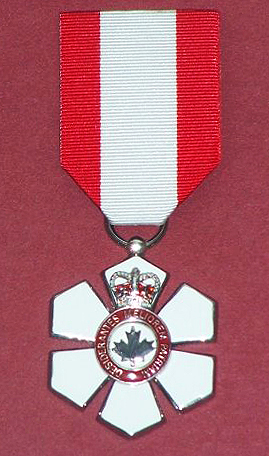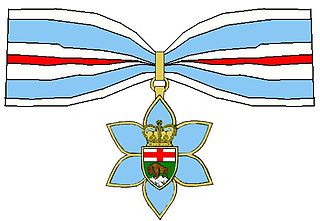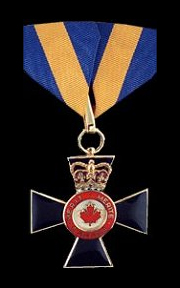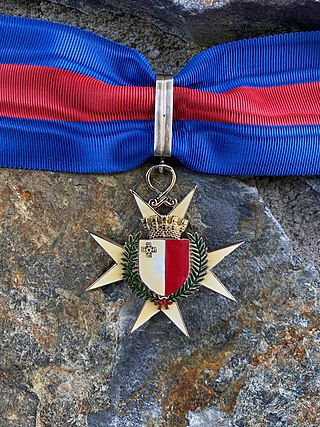
The Order of Canada is a Canadian state order and the second-highest honour for merit in the system of orders, decorations, and medals of Canada, after the Order of Merit.

The Most Excellent Order of the British Empire is a British order of chivalry, rewarding contributions to the arts and sciences, work with charitable and welfare organizations, and public service outside the civil service. It was established on 4 June 1917 by King George V and comprises five classes across both civil and military divisions, the most senior two of which make the recipient either a knight if male or dame if female. There is also the related British Empire Medal, whose recipients are affiliated with, but not members of, the order.

The Order of Merit is an order of merit for the Commonwealth realms, recognising distinguished service in the armed forces, science, art, literature, or the promotion of culture. Established in 1902 by Edward VII, admission into the order remains the personal gift of its Sovereign—currently Edward VII's great-great-grandson, Charles III—and is restricted to a maximum of 24 living recipients from the Commonwealth realms, plus a limited number of honorary members. While all members are awarded the right to use the post-nominal letters OM and wear the badge of the order, the Order of Merit's precedence among other honours differs between countries.

The Royal Victorian Order is a dynastic order of knighthood established in 1896 by Queen Victoria. It recognises distinguished personal service to the monarch, members of the royal family, or to any viceroy or senior representative of the monarch. The present monarch, King Charles III, is the sovereign of the order. The order's motto is Victoria. The order's official day is 20 June. The order's chapel is the Savoy Chapel in London.

The Order of British Columbia is a civilian honour for merit in the Canadian province of British Columbia. Instituted in 1989 by Lieutenant Governor David Lam, on the advice of the Cabinet under Premier Bill Vander Zalm, the order is administered by the Governor-in-Council and is intended to honour current or former British Columbia residents for conspicuous achievements in any field, being thus described as the highest honour amongst all others conferred by the British Columbia Crown.
The Alberta Order of Excellence is a civilian honour for merit in the Canadian province of Alberta. Instituted in 1979 when Lieutenant Governor Frank C. Lynch-Staunton granted royal assent to the Alberta Order of Excellence Act, the order is administered by the Governor-in-Council and is intended to honour current or former Alberta residents for conspicuous achievements in any field, being thus described as the highest honour amongst all others conferred by the Canadian Crown in right of Alberta.
The Saskatchewan Order of Merit is a civilian honour for merit in the Canadian province of Saskatchewan. Instituted in 1985 by Lieutenant Governor Frederick Johnson, on the advice of the Cabinet under Premier Grant Devine, the order is administered by the Governor-in-Council and is intended to honour current or former Saskatchewan residents for conspicuous achievements in any field, being thus described in law as the highest honour amongst all others conferred by the Saskatchewan Crown.
The Order of New Brunswick is a civilian honour for merit in the Canadian province of New Brunswick. Instituted in 2000 by Lieutenant Governor Marilyn Trenholme Counsell, on the advice of the Cabinet under Premier Bernard Lord, the order is administered by the Governor-in-Council and is intended to honour current or former New Brunswick residents for conspicuous achievements in any field, being thus described as the highest honour amongst all others conferred by the New Brunswick Crown.
The Order of Newfoundland and Labrador is a civilian honour for merit in the Canadian province of Newfoundland and Labrador. Instituted in 2001, when Lieutenant Governor Arthur Maxwell House granted Royal Assent to the Order of Newfoundland and Labrador Act, the order is administered by the Governor-in-Council and is intended to honour current or former Newfoundland and Labrador residents for conspicuous achievements in any field, being thus described as the highest honour amongst all others conferred by the Newfoundland and Labrador Crown.
The Order of Prince Edward Island is a civilian honour for merit in the Canadian province of Prince Edward Island. Instituted in 1996 by Lieutenant Governor Gilbert Clements, on the advice of the Cabinet under Premier Catherine Callbeck, the order is administered by the Governor-in-Council and is intended to honour current or former Prince Edward Island residents for conspicuous achievements in any field, being thus described as the highest honour amongst all others conferred by the Prince Edward Island Crown.

The Order of Manitoba is a civilian honour for merit in the Canadian province of Manitoba. Instituted in 1999 when Lieutenant Governor Peter Liba granted royal assent to the Order of Manitoba Act, the order is administered by the Governor-in-Council and is intended to honour current or former Manitoba residents for conspicuous achievements in any field, being thus described as the highest honour amongst all others conferred by the Manitoba Crown.

The Order of Nova Scotia is a civilian honour for merit in the Canadian province of Nova Scotia. Instituted on August 2, 2001, when Lieutenant Governor Myra Freeman granted Royal Assent to the Order of Nova Scotia Act, the order is administered by the Governor-in-Council and is intended to honour current or former Nova Scotia residents for conspicuous achievements in any field, being thus described as the highest honour amongst all others conferred by the Nova Scotia Crown.

The Order of Merit of the Police Forces is an honour for merit that is, within the Canadian system of honours, the only such fellowship reserved for only members of Canada's various police forces. Created in 2000, the order is administered by the Governor in Council, on behalf of the Canadian monarch. Appointment to the order recognizes conspicuous merit and exceptional service, the level of which is reflected by the organization's three hierarchical grades.
The orders, decorations, and medals of Canada comprise a complex system by which Canadians are honoured by the country's sovereign for actions or deeds that benefit their community or the country at large. Modelled on its British predecessor, the structure originated in the 1930s, but began to come to full fruition at the time of Canada's centennial in 1967, with the establishment of the Order of Canada, and has since grown in both size and scope to include dynastic and national orders, state, civil, and military decorations; and various campaign medals. The monarch in right of each Canadian province also issues distinct orders and medals to honour residents for work performed in just their province. The provincial honours, as with some of their national counterparts, grant the use of post-nominal letters and or supporters and other devices to be used on personal coats of arms.
The orders, decorations, and medals of the Canadian provinces, in which each province of Canada has devised a system of orders and other awards to honour residents for actions or deeds that benefit their local community or province, are in turn subsumed within the Canadian honours system. Each province sets its own rules and criteria for eligibility and also for how each award is presented. Most of the awards allow for the recipients to wear their awards in public, and most grant the recipients the use of post-nominal letters after their names. Not all of the awards listed below are part of the Canadian honours system, thus some of them may not be worn or court mounted with awards that are part of the Canadian honours system.

Appointment to the Order of Canada is the process by which citizens of Canada or certain foreign persons are inducted into the Order of Canada, the second-highest civilian honour within the Canadian system of honours. Any living Canadian or foreign national may be nominated for appointment; however, the advisory council of the Order of Canada and the Governor General of Canada make the final decision on appointments. Recipients of the order may also be promoted to a higher grade within it if they have continued to provide outstanding service to Canada, or to humanity in general, after their appointment.

The Meritorious Service Cross is a decoration that is, within the Canadian system of honours, one of the two Meritorious Service Decorations gifted by the Canadian monarch, his or her Governor-in-Council. Created in 1984, the medal is intended to recognize individuals—both Canadian and foreign—who have carried out meritorious acts bringing benefit and honour in either of two categories: military and civilian.

The Order of Military Merit is a military honour for merit that is, within the Canadian system of honours, the second highest order administered by the governor in Council on behalf of the Canadian monarch.

The lieutenant governor of Ontario is the representative in Ontario of the Canadian monarch, King Charles III, who operates distinctly within the province but is also shared equally with the ten other jurisdictions of Canada, as well as the other Commonwealth realms and any subdivisions thereof, and resides predominantly in his oldest realm, the United Kingdom. The lieutenant governor of Ontario is appointed in the same manner as the other provincial viceroys in Canada and is similarly tasked with carrying out most of the monarch's constitutional and ceremonial duties. The current lieutenant governor of Ontario is Edith Dumont, sworn in on November 14, 2023.

The National Order of Merit is a state order of the Republic of Malta. The order is divided into four grades that may be awarded to Maltese citizens.















